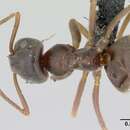en
names in breadcrumbs


Taxonomic history
Foerster, 1850a: 71 (q.); Wheeler & Wheeler, 1953c PDF: 147 (l.); Hauschteck, 1962 PDF: 219 (k.).Combination in Lasius: Mayr, 1861 PDF: 49.Combination in Donisthorpea: Donisthorpe, 1915f: 212.Combination in Formicina: Emery, 1916a PDF: 240.Combination in Acanthomyops: Ruzsky, 1925b PDF: 44.Combination in Lasius: Menozzi, 1921 PDF: 32; Müller, 1923b PDF: 125; Emery, 1925d PDF: 230; Kuznetsov-Ugamsky, 1929a PDF: 27.Subspecies of Lasius niger: Forel, 1874 PDF: 46; Mayr, 1886d PDF: 429; Forel, 1892j PDF: 307; Forel, 1904c PDF: 386; Wheeler, 1906h PDF: 322; Forel, 1913d PDF: 438; Forel, 1915d: 53; Emery, 1916a PDF: 240; Santschi, 1925g PDF: 349; Karavaiev, 1927d: 280; Menozzi, 1936b PDF: 305; Menozzi, 1939a PDF: 312.Status as species: Saunders, 1880 PDF: 209; André, 1882c PDF: 192; Nasonov, 1889: 22; Emery, 1897g: 238; Ruzsky, 1902d PDF: 16; Emery, 1908e PDF: 24; Bondroit, 1911a PDF: 11; Donisthorpe, 1915f: 212; Bondroit, 1918 PDF: 25; Stitz, 1939: 279; Novák & Sadil, 1941 PDF: 101; Röszler, 1942a PDF: 53; Stärcke, 1944b PDF: 153; Wilson, 1955a PDF: 77; Baroni Urbani, 1971c PDF: 200; Kutter, 1977c: 227; Collingwood, 1979 PDF: 97; Yamauchi, 1979 PDF: 156; Collingwood, 1982 PDF: 285; Kupyanskaya, 1990a: 218; Atanassov & Dlussky, 1992: 237; Seifert, 1992b PDF: 13; Schär et al., 2018 10.1111/jbi.13380 PDF: 6.Senior synonym of Lasius americanus, Lasius pannonica and material of the unavailable names Lasius alienoamericanus, Lasius flavidus, Lasius turkmenus referred here: Wilson, 1955a PDF: 77.See also: Seifert, 2020 10.25674/so92iss1pp15 PDF: 61.Records
(Map 50): Bulgaria ( Agosti and Collingwood 1987a , Atanassov and Dlusskij 1992 , Seifert 1992 ); Western Predbalkan: Rachene river valley ( Vassilev 1984 ); Western Stara Planina Mts: Lakatnik station (Vratsa district) ( Atanassov 1936 ); Konyavska Planina Mt.: Uglyartsi vill. ( Lapeva-Gjonova 2004b ); Sofia Basin: Sofia ( Forel 1892 , Lapeva-Gjonova and Atanasova 2004 , Antonova 2004 , 2005 , Antonova and Penev 2006 , Hlaváč et al. 2007 ), the surroundings of Sofia near Vladaya vill. ( Antonova and Penev 2006 , 2008 ); Vitosha Mt. ( Atanassov 1936 , 1952 , Hlaváč et al. 2007 ): Knyazhevo ( Forel 1892 ); Plana Mt.: Pasarel vill. ( Hlaváč et al. 2007 , Vagalinski and Lapeva-Gjonova in press ); Tsiganka peak (Pasarel vill.), Bukov dol loc. (Pasarel vill.), Plana vill., Peyova buka hut (Pasarel vill.), Alino vill. ( Vagalinski and Lapeva-Gjonova in press ); Lozenska Planina Mt. ( Vassilev and Evtimov 1973 ): near German monastery ( Antonova and Penev 2008 ); Bakadzhik-Burgas district: Aytos ( Forel 1892 ); Strandzha Mt. ( Antonova et al. in press ); Krupnik-Sandanski- Petrich Valley: along Strumeshnitsa river ( Atanassov 1964 ); Belasitsa Mt. ( Atanassov 1964 ); Rila Mt.: Rila monastery, the valley of Rilska river ( Forel 1892 ); Western Rhodopi Mts: Chepintsi vill., Arda vill., Koshnitsa vill. ( Hlaváč et al. 2007 ), Dospat, Smolyan, Rakitovo, Velingrad, Chepelare ( Lapeva-Gjonova in press (a) ); Eastern Rhodopi Mts: Kokiche vill. (Kardzhali), Dedets vill. (Zlatograd), Dyadovtsi vill. (Ardino), Madzharovo, Zvezdel vill. (Momchilgrad), between Dabovets vill. and Kamilski dol vill. (Ivaylovgrad), between Odrintsi vill. and Svirachi vill. (Ivaylovgrad), Svirachi vill. (Ivaylovgrad), Zhelezino vill. (Ivaylovgrad), Meden buk vill. (Ivaylovgrad) ( Lapeva-Gjonova 2004a ); Northern Black Sea coast: Evksinograd palace ( Atanassov 1936 ); Southern Black Sea coast: Veselie vill. ( Forel 1892 ).
Notes:
Seifert (1992) has divided the former " Lasius alienus " into several species, three of which are found in Bulgaria: Lasius alienus , Lasius paralienus and Lasius psammophilus . Consequently, records of Lasius alienus in all papers before 1992 may refer to any of these species.
Laverdure (sur les chênes-liège ); Bône .
Himalaya, 9,000 ' de hauteur (M. Smythies). [[ queen ]] L. 2, 7 a 3, 2 mill. Pas de sillon frontal distinct. Brunatre, avec le thorax les antennes et les pattes plus clairs. Scapes et pattes sans poils dresses. Comme les petits exemplaires clairs d'Europe.
Ouvriere: Antennes de 9 articles. Tout le corps lisse et tres luisant. D'un brun-marron fonce, presque noir; mandibules et partie anterieure de la tete plus rougeatres; antennes, articulations des pattes et tarses d'un jaune sale. Pubescence nulle; pilosite tres eparse; funicule avec une pubescence un peu relevee et assez abondante. Pronotum et mesonotum formant ensemble (vus en dessus) un hemisphere un peu aplati; mesonotum separe du metanotum par un profond etranglement; face basale du metanotum horizontale, au moins aussi longue que sa face declive. Ecaille cuneiforme, un peu inclinee en avant, tres epaisse a la base, amincie et plus ou moins echancree au sommet. - Long., 1 2 / 3 - 2 mill.
Cuba.
Parait etre voisine de la M. Kraatzi Roger , qui ne m'est connue que par la description de son auteur, mais s'en eloigne par sa couleur tout autre et par la conformation de son petiole.
Lasius alienus, or cornfield ant,[1] is a species of ant in the subfamily Formicinae (family Formicidae). Workers have a length of about 2–4 mm, Queens are larger (7–9 mm).
They live in Europe, from Spain to the Caucasus; populations in North America are now considered to be a separate species, Lasius americanus.[2]
Genome type Lasius alienus: 0,31 m (C value)[3][4]
The butterfly Plebejus argus lays eggs near nests of the ant L. alienus, forming a mutualistic relationship.[5] This mutualistic relationship benefits the adult butterfly by reducing the need for parental investment.[5] Once the eggs hatch, the ants chaperone the larvae, averting the attacks of predatory organisms like wasps and spiders as well as parasites. In return, the ants receive a saccharine secretion fortified with amino acids from an eversible gland on the larvae's back.[5] As first instar larvae prepare to pupate, the ants carry the larvae into their nests.[5] Once the larvae become pupae, the ants continue to provide protection against predation and parasitism.[5]
Lasius alienus, or cornfield ant, is a species of ant in the subfamily Formicinae (family Formicidae). Workers have a length of about 2–4 mm, Queens are larger (7–9 mm).